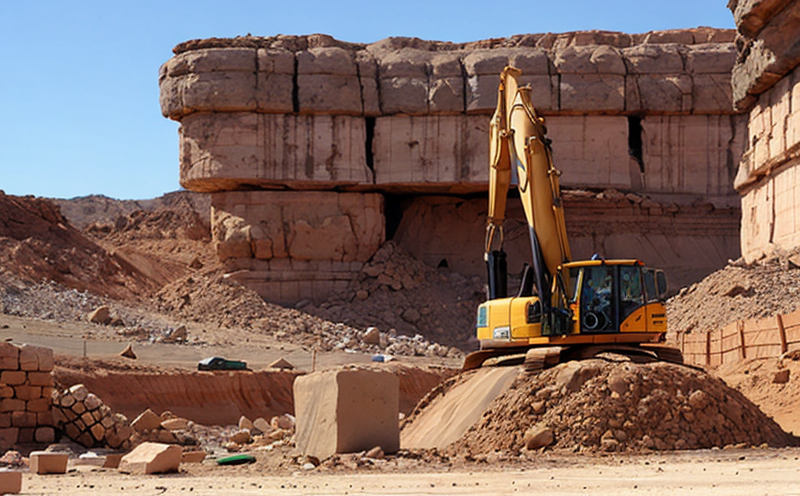DIN 18132 Flexural Strength of Rock Materials
The DIN 18132 standard provides a comprehensive framework for determining the flexural strength of rock materials, which is essential in mining and civil engineering applications. This test assesses the resistance of rock materials to bending stress, offering insights into their structural integrity under load. The procedure is particularly relevant for evaluating the durability and stability of rocks used in excavation projects, tunneling, and ground support.
The flexural strength test according to DIN 18132 involves the preparation of specimens cut from the rock material being tested. These specimens are subjected to a uniformly distributed load until failure occurs. The maximum bending stress at which the specimen breaks is recorded as the flexural strength value, expressed in megapascals (MPa).
The accuracy and precision of this test depend on several factors including the quality of specimen preparation, uniform loading, and proper testing environment control.
| Specimen Preparation | Loading Method | Testing Environment |
|---|---|---|
| Careful trimming to ensure flat surfaces and consistent dimensions | Use of a three-point bending test setup with constant loading rate | Controlled temperature and humidity conditions |
| Evaluation of rock properties such as grain size, porosity, and mineral composition | Monitoring the load-deflection behavior to identify the point of failure | Avoidance of external interference during testing |
The DIN 18132 test is widely used in mining operations due to its relevance in assessing rock stability and structural integrity. This information helps engineers design safer tunnels, shafts, and ground support systems.
For example, understanding the flexural strength of rock materials can prevent accidents caused by unexpected failures during excavation or tunneling processes. Moreover, this test ensures compliance with safety regulations and enhances overall project efficiency.
Benefits
The flexural strength testing according to DIN 18132 offers several advantages that are crucial for ensuring the reliability of rock materials in mining operations:
- Enhanced Safety: By identifying weak points within rocks, engineers can implement appropriate safety measures during excavation and tunneling processes.
- Cost Efficiency: Early detection of potential failure points reduces the risk of costly repairs or accidents later on in the project lifecycle.
- Regulatory Compliance: Adhering to international standards like DIN 18132 ensures that projects meet all necessary regulatory requirements, thereby avoiding legal issues and penalties.
- Improved Design: Accurate flexural strength data allows for more precise engineering decisions leading to optimized designs with better performance characteristics.
Overall, this testing method contributes significantly towards creating safer working environments while also optimizing resource utilization throughout mining operations.
International Acceptance and Recognition
DIN 18132 is recognized globally for its robustness in assessing the flexural strength of rock materials. Its acceptance extends beyond Germany, making it a preferred choice among international mining companies and research institutions.
The standard's widespread adoption can be attributed to several factors:
- Universal Application: The standardized procedures ensure consistent results across different regions and laboratories.
- Transparency: Clear guidelines promote greater transparency in testing methods, which is vital for maintaining trust among stakeholders.
- Harmonization with Other Standards: DIN 18132 aligns well with other international standards such as ISO and ASTM, facilitating seamless integration into various global projects.
Incorporating this standard in your testing protocols guarantees compatibility with industry best practices worldwide. This recognition not only enhances credibility but also fosters collaboration between local and international teams involved in mining initiatives.
Use Cases and Application Examples
| Application Scenario | Description |
|---|---|
| Tunnel Construction | Evaluating rock strength before initiating tunneling operations to prevent unexpected collapses. |
| Shaft Design | Assessing the stability of shaft walls by determining their flexural resistance under load. |
| Ground Support Systems | Selecting appropriate materials for ground support systems based on their flexural strength values. |
| Rock Mass Rating (RMR) | Calculating the RMR value which is used in predicting rock mass stability during excavation. |
In addition to these primary applications, the results from DIN 18132 flexural strength tests can be utilized for:
- Material Selection: Choosing suitable rock types for specific mining applications based on their mechanical properties.
- Quality Control: Ensuring consistency in raw materials used throughout the project lifecycle.
- Research and Development: Investigating new rock types or composite materials designed to meet specific performance criteria.
The versatility of this testing method makes it indispensable for various stages of mining projects, from initial feasibility studies to final quality assurance checks.





